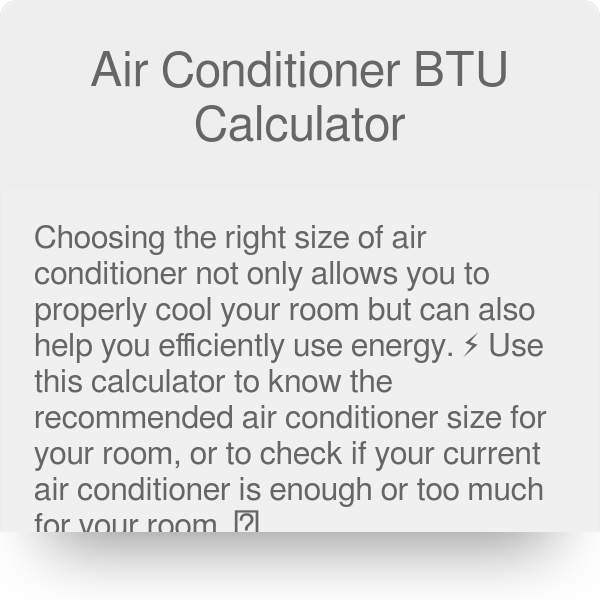


In most cases, leave this as default “Average” value. Step 6 (Windows/Doors air tightness): Select appropriate window/door insulation level. If you have more than 1 window, for every 8 feet of exterior wall length, select “More than Average” If you have ~1 window or fewer, for every 8 feet of exterior wall length, select “Average Amount”.
#AC BTU CALCULATOR WINDOWS#
Step 6 (Windows): Select the average amount of windows in your home. If your primary reason for installing a new HVAC system is cooling, we recommend using “Less than Average” value, to not over-size your cooling equipment. These two values are most critical in terms of heating, where your heat loss will be the highest. If you have partially insulated home, select “Less than Average” or “Poorly Insulated”. In most cases you should not use “Very Well Insulated” value, unless you have a “Super-insulated” house.

In this case, select “More than Average” value. If you have a newer home with 6″ studs, will have R-18 insulation. If this matches your home, leave this value as default (Avg. Step 5 (Insulation Grade): Most homes in US built between 19 will have 4″ studs with R-13 wall insulation, and should have R-38 roof / attic insulation. In that case, your average Ceiling Height is 10 ft: high, and the highest point on the ceiling is 12 ft. However if you have high ceilings, or cathedral/vaulted ceilings, the VOLUME of your space will be higher.įor cathedral/vaulted ceilings, add the lowest wall height + peak height, and divide by 2, to get the average. In most cases this value should be equal to 8 ft. Step 4 (Space Height): Select average Ceiling Height of your house. installing multiple single-zone Ductless heat-pump systems, in our Mini Split DIY installation guide. This value is most useful for figuring out which type of Ductless Mini-Split system to use.Īdditionally, we discuss the PROS & CONS of using a multi-zone vs. If you plan to use a Central AC + Warm Air Furnace (ducted) system, or a Boiler for heating, the number of zones is not very important in terms of estimating heat load. Step 3 (Rooms / Zones): Enter number of Rooms/Zones where you want a new Heating/Cooling system installed. This step is Critical for the accurate estimation of the annual heating/cooling load of your HVAC system! If you leave all settings as default, and only change the Region from 1 to 5 and back, you will see a huge change in Cooling/Heating BTU load. Step 2 (Area Size): Enter square footage for your house/building or a specific area, for which you are doing the calculations. If you live TX, select Region 5 (red), etc. For example, if you live in NYC or NJ, select Region 3 (yellow). Step 1 (Climate Region): Select your Climate Region, using the Region Map at the top on the calculator.


 0 kommentar(er)
0 kommentar(er)
